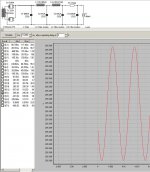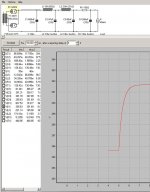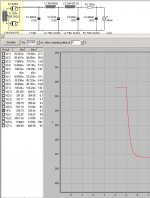Hi all,
could I get a few of you vets to take a brief look at my PSUD2 sheet. This is for an Aikido linestage B+ supplying 4 6SN7s, using a 5AR4 rectifier and a Hammond 272FX (300-0-300, 146VA, 5V@3A, 6.3V@5A.)
I set a 40mA load taking 10mA plate load from the 6SN7 data sheet.
I found a formula to calculate inductance, I ended up with 7.5H although I'm not sure if that should be total or just the first choke.
I hope I understand correctly from reading on the forum that the first cap will limit turn on/off voltage spikes.
After reading Jim Hagerman's snubber paper, (and understanding too little despite it's clarity,) I tried calculating an RC section but the one I ended up with seemed to get the ripple down from 40mV pp to 1.4mV. I don't know how oscillation will be affected, if the PSUD2 scope is to be a guide, it looked pretty good.
Voltage at I1 is 295V which seems like a good deal.
I'd appreciate hearing concerns, improvements, and other tips that will help, especially in keeping me alive and the Aikido working well. I've decided to follow John Broskie's recommendation to employ a choke based filter although I have read several posters claim that this is an unneccessary expense.
thanks,
gary
could I get a few of you vets to take a brief look at my PSUD2 sheet. This is for an Aikido linestage B+ supplying 4 6SN7s, using a 5AR4 rectifier and a Hammond 272FX (300-0-300, 146VA, 5V@3A, 6.3V@5A.)
I set a 40mA load taking 10mA plate load from the 6SN7 data sheet.
I found a formula to calculate inductance, I ended up with 7.5H although I'm not sure if that should be total or just the first choke.
I hope I understand correctly from reading on the forum that the first cap will limit turn on/off voltage spikes.
After reading Jim Hagerman's snubber paper, (and understanding too little despite it's clarity,) I tried calculating an RC section but the one I ended up with seemed to get the ripple down from 40mV pp to 1.4mV. I don't know how oscillation will be affected, if the PSUD2 scope is to be a guide, it looked pretty good.
Voltage at I1 is 295V which seems like a good deal.
I'd appreciate hearing concerns, improvements, and other tips that will help, especially in keeping me alive and the Aikido working well. I've decided to follow John Broskie's recommendation to employ a choke based filter although I have read several posters claim that this is an unneccessary expense.
thanks,
gary
Attachments
Gary,
In line with what Sy is saying -- there is some information in my Aikido thread which discusses what to look for in the impulse response. I tried to make the information useful for others like you.
I'm a power supply design beginner too, but after playing with a real power supply for a while, I've confirmed the impulse approach holds up in real supplies so I recommend it as a good design methodology, at least as a good starting point.
I've modeled your power supply so can follow along with your efforts. Homework question for you if you are game - how does your power supply's impulse response differ from the "ideal", as suggested by the impulse theory?
I have some other comments too on your supply on how to size the inductors and caps, and the optimum number of cells. I made a good improvement to my supply today which may help you, which I'm going to describe when I have more time to write it up tomorrow in my thread.
In line with what Sy is saying -- there is some information in my Aikido thread which discusses what to look for in the impulse response. I tried to make the information useful for others like you.
I'm a power supply design beginner too, but after playing with a real power supply for a while, I've confirmed the impulse approach holds up in real supplies so I recommend it as a good design methodology, at least as a good starting point.
I've modeled your power supply so can follow along with your efforts. Homework question for you if you are game - how does your power supply's impulse response differ from the "ideal", as suggested by the impulse theory?
I have some other comments too on your supply on how to size the inductors and caps, and the optimum number of cells. I made a good improvement to my supply today which may help you, which I'm going to describe when I have more time to write it up tomorrow in my thread.
Thanks Cappy,
If I remember correctly didn't you start the YAAB thread? I have intersected it in my searches many times. You are using the TentLabs DC regulator boards, right? I'm glad you fielded this endeavor on the forum, it's nice to see common problems being tackled. That said, much of it is yet over my head. I don't have a PC so I have to climb in through my neighbor's window when he's not home and use his fr PSUD2. I'll try the varied current load simulations. So many advise on the forum to be liberal when specing a transformer. Clearly the one I have in mind can provide 2X the max current consumed by the 6SN7 heaters, and 5X that required by the rectifier tube. My understanding is that this is the most important consideration, (given decent design,) in maintaining consistent voltage and current supply. I look forward to checking in with you soon.
gary
If I remember correctly didn't you start the YAAB thread? I have intersected it in my searches many times. You are using the TentLabs DC regulator boards, right? I'm glad you fielded this endeavor on the forum, it's nice to see common problems being tackled. That said, much of it is yet over my head. I don't have a PC so I have to climb in through my neighbor's window when he's not home and use his fr PSUD2. I'll try the varied current load simulations. So many advise on the forum to be liberal when specing a transformer. Clearly the one I have in mind can provide 2X the max current consumed by the 6SN7 heaters, and 5X that required by the rectifier tube. My understanding is that this is the most important consideration, (given decent design,) in maintaining consistent voltage and current supply. I look forward to checking in with you soon.
gary
With regards to your issue of snubbers, I too have read Jim Hagerman's article numerous times, but in practice, have found o-scope/test/trial/error to be the most reliable method. It is also not always practical to calculate (or approximate) C and L values to plug into his equations. If anything, they give you a ballpark of where to start for C values.
I also would say PSUD will probably not help you to identify proper R-C snubbers for reducing transients (reverse recovery, inductive kickback). My process may not be the best method, but it works pretty well for me. I can give some advice in this area if you are interested, but you might be preoccupied at this point with getting good transient response per the above suggestions.
Fortunately, snubber selection is fairly independent of C-L-C-L-C design, so once you establish the filter components, you can proceed into snubber selection.
Good luck. PSUD is a great little tool, and gives surprisingly accurate results.
I also would say PSUD will probably not help you to identify proper R-C snubbers for reducing transients (reverse recovery, inductive kickback). My process may not be the best method, but it works pretty well for me. I can give some advice in this area if you are interested, but you might be preoccupied at this point with getting good transient response per the above suggestions.
Fortunately, snubber selection is fairly independent of C-L-C-L-C design, so once you establish the filter components, you can proceed into snubber selection.
Good luck. PSUD is a great little tool, and gives surprisingly accurate results.
Zigzagflux,
I would definitely be interested. After my last partially successful preamp build I decided to learn a lot more before rushing into the next one. This means that I will plan as much as I can before ordering all the parts. This is all to say that I won't be able to physically test the circuit for a few weeks but if you think your snubber advice will suffer this abstraction, by all means lay it on me.
thanks,
gary
I would definitely be interested. After my last partially successful preamp build I decided to learn a lot more before rushing into the next one. This means that I will plan as much as I can before ordering all the parts. This is all to say that I won't be able to physically test the circuit for a few weeks but if you think your snubber advice will suffer this abstraction, by all means lay it on me.
thanks,
gary
Gary,
Yes, I started that thread. For me the power supply is the most interesting part of the project.
Yes, I am using the Tentlabs boards. So far so good with them. I have another filament transformer I need to use that supplies higher amperage for 6CG7s. My current transformer supplies 6.6 v but the Tentlabs boards can't handle more than about 1 amp of filament current at that voltage. Just be aware if you use the Tentlabs IDHT supplies they need probably around 7 volts ac in. Also, I'm sure they will work at the higher amp draw, but I haven't tried them doing that yet.
If you want to buy versus make your own, like I did, another idea, at about the same price, is to get a pair of the DIY HiFi Supply Heater Supplies. I have these in my Lux amp and they are very good. They would be complete overkill for IDHT supplies, but you could possibly reuse them later if you ever wanted them for DHT supplies. Also, a single one might barely work for 4 6CG7 IDHT filaments.
Your transformer specs sound fine.
So when you get PC access you can report your findings on the ideal impulse response versus your design's response and we will go from there...
Yes, I started that thread. For me the power supply is the most interesting part of the project.
Yes, I am using the Tentlabs boards. So far so good with them. I have another filament transformer I need to use that supplies higher amperage for 6CG7s. My current transformer supplies 6.6 v but the Tentlabs boards can't handle more than about 1 amp of filament current at that voltage. Just be aware if you use the Tentlabs IDHT supplies they need probably around 7 volts ac in. Also, I'm sure they will work at the higher amp draw, but I haven't tried them doing that yet.
If you want to buy versus make your own, like I did, another idea, at about the same price, is to get a pair of the DIY HiFi Supply Heater Supplies. I have these in my Lux amp and they are very good. They would be complete overkill for IDHT supplies, but you could possibly reuse them later if you ever wanted them for DHT supplies. Also, a single one might barely work for 4 6CG7 IDHT filaments.
Your transformer specs sound fine.
So when you get PC access you can report your findings on the ideal impulse response versus your design's response and we will go from there...
Regarding Sy's comment:
<<It's a tube rectifier, so it's worthwhile to run it longer before the bounce>>
My version of PSUD doesn't appear to simulate tube warmup, so 4 seconds is fine. Steady state with a 5ar4 is after a few seconds, which now that Sy mentions it, isn't correct!
Given that you are somewhat confused as to the methodology, I'd stick with my recommended values for now.
If you want to use Sy's numbers, be sure to take that into account in the Constant Current Source dialog where you enter value1, value2, and the time in seconds. Otherwise you are going to be doing a lot of climbing in and out of your neighbor's window.
<<It's a tube rectifier, so it's worthwhile to run it longer before the bounce>>
My version of PSUD doesn't appear to simulate tube warmup, so 4 seconds is fine. Steady state with a 5ar4 is after a few seconds, which now that Sy mentions it, isn't correct!
Given that you are somewhat confused as to the methodology, I'd stick with my recommended values for now.
If you want to use Sy's numbers, be sure to take that into account in the Constant Current Source dialog where you enter value1, value2, and the time in seconds. Otherwise you are going to be doing a lot of climbing in and out of your neighbor's window.
stepped simulation results
SY, Cappy,
here are the results of 2 PSUD2 sims. 10sec with 4sec reporting delay. Stepped from 40-35mA and 40-45mA respectively. It seems that there is little sproing but the transient time (what's this called?) might be better. What do you think?
The second one to follow
thanks,
gary
SY, Cappy,
here are the results of 2 PSUD2 sims. 10sec with 4sec reporting delay. Stepped from 40-35mA and 40-45mA respectively. It seems that there is little sproing but the transient time (what's this called?) might be better. What do you think?
The second one to follow
thanks,
gary
Attachments
Alright, you nailed it!
The transient time sucks: 2 seconds.
The Aikido is class A so actually probably doesn't have such current changes, but if it did would 2 seconds be acceptable? No way.
Even in the Class A Aikido I've noticed a strong correlation between a quick impulse response and good sound.
The transient time sucks: 2 seconds.
The Aikido is class A so actually probably doesn't have such current changes, but if it did would 2 seconds be acceptable? No way.
Even in the Class A Aikido I've noticed a strong correlation between a quick impulse response and good sound.
Sy,
Ah, well at least this thread suddenly got very interesting.
With the Swenson methodology, if I understand it correctly (perhaps I don't), he's looking for very quick response with a slight overshoot and then damped down quick. I can see intuitively where a power supply should be nimble in a certain way.
At the same time I understand where you are coming from too, and what you say does make some sense to me, that a power supply should be like a rock.
But in my (limited) real world experience this kind of transient behavior can sound dullsville and/or frequency unbalanced. The quick response ones sound better.
Thoughts?
Ah, well at least this thread suddenly got very interesting.
With the Swenson methodology, if I understand it correctly (perhaps I don't), he's looking for very quick response with a slight overshoot and then damped down quick. I can see intuitively where a power supply should be nimble in a certain way.
At the same time I understand where you are coming from too, and what you say does make some sense to me, that a power supply should be like a rock.
But in my (limited) real world experience this kind of transient behavior can sound dullsville and/or frequency unbalanced. The quick response ones sound better.
Thoughts?
- Status
- This old topic is closed. If you want to reopen this topic, contact a moderator using the "Report Post" button.
- Home
- Amplifiers
- Tubes / Valves
- Help please checking my B+ design


